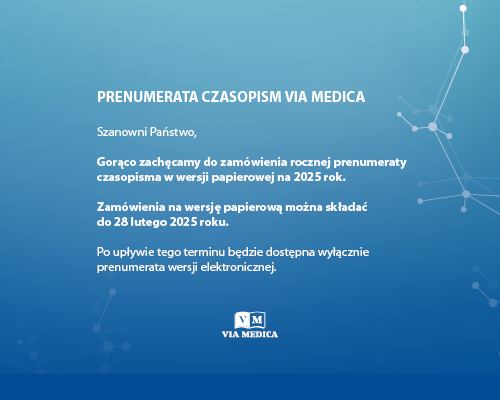Tom 5, Nr 4 (2012)
Praca badawcza (oryginalna)
Opublikowany online: 2012-12-17
Wyświetlenia strony
844
Wyświetlenia/pobrania artykułu
1214
Działalność jednostek organizacyjnych
Journal of Transfusion Medicine 2012;5(4):159-170.
Streszczenie
Wstęp: Celem niniejszego opracowania było przedstawienie podstawowych aspektów działalności
jednostek organizacyjnych polskiej służby krwi w 2011 roku.
Materiał i metody: Analiza danych dostarczonych przez Regionalne Centra Krwiodawstwa
i Krwiolecznictwa (RCKiK).
Wyniki: W 2011 roku na terenie Polski działało 21 RCKiK i 158 oddziałów terenowych
(OT). Przeprowadzono 9856 ekip wyjazdowych. Krew oddawało 608 590 osób, z czego większość
stanowili dawcy honorowi (607 737, w tym 45 415 dawców rodzinnych i 816 dawców
autologicznych). Najczęściej pobierano krew pełną (1 135 376 donacji), najrzadziej — koncentrat
granulocytarny (146 donacji) i KKCz metodą aferezy (193 donacje). Krew pełną pobierano
przede wszystkim w OT (48,8% donacji), rzadziej w siedzibach RCKiK (26,6%) i w czasie
ekip wyjazdowych (24,6%). Najwięcej krwi pełnej pobrano w czasie ekip wyjazdowych
w RCKiK Katowicach i Radomiu (> 40%). Najczęściej otrzymywane składniki krwi to KKCz
(1 126 768 j.) i FFP (1 190 795 j., z czego do celów klinicznych wydano około 31,7%). W 2011
roku otrzymano w sumie 57 706 opakowań zlewanego KKP i 40 865 opakowań KKP z aferezy.
Dodatkowe metody preparatyki (usuwanie leukocytów, napromieniowanie) stosowano znacznie
częściej w stosunku do KKP (79,79% UKKP i 53,39% NKKP) niż KKCz (13,05% UKKCz
i 5,56% NKKCz). Inaktywacji czynników zakaźnych poddano łącznie 4,42% wydanych do
szpitali jednostek FFP i 7,71% opakowań KKP.
Wnioski: Dane przedstawione w niniejszym opracowaniu mogą okazać się przydatne do
oceny różnych aspektów funkcjonowania jednostek organizacyjnych polskiej służby krwi
i umożliwić poszczególnym jej placówkom porównanie doświadczeń i stosowanych metod działania
celem dalszego ich doskonalenia.
Słowa kluczowe: krwiodawcykrwiodawstwoskładniki krwi





